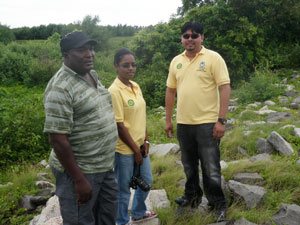COMMUNITY Development Officer of the Mangrove Restoration Project, Mr. Ryan Tulsieram, has said a Village Mangrove Action Committee Groups [VMAC] will be formed as part of a mangrove awareness programme in Region Two (Essequibo Coast and Islands).
 Speaking to the media from the La Belle Alliance foreshore, where Mangrove seedlings were planted several months ago, Mr. Tulsieram said the aim of the project is to get the community involved by using people to reach out to others in their respective villages by way of flyers, so as to inform them about the importance of the Mangrove Restoration Project.
Speaking to the media from the La Belle Alliance foreshore, where Mangrove seedlings were planted several months ago, Mr. Tulsieram said the aim of the project is to get the community involved by using people to reach out to others in their respective villages by way of flyers, so as to inform them about the importance of the Mangrove Restoration Project.
Tulsieram said a team comprising of himself, Engineer Ms. Ranata Robertson and Monitoring Officer, Mr. Rudolph Adams from the Mangrove Restoration Project visited the Region to look at the sites identified for mangrove planting, and at the same time to look at the La Belle Alliance/Richmond area, where some residents are destroying the mangrove vegetation, as was reported in the Guyana Chronicle and Times newspapers.
The three-member team, accompanied by Regional Agricultural Officer Mr. Kaimraj Nauth Kandhai, inspected the mangrove vegetation on the Richmond/La Belle Alliance foreshore in an effort to verify the area where the cutting is taking place.
Ms. Robertson said the project has a work plan, and five sites have already been identified for mangroves planting along the foreshore. These are Anna Regina, Devonshire Castle, Lima, La Belle Alliance and Andrews, and these sites will be monitored as part of the engineering activities. She said the sites were selected based on favourable conditions, like accretion for the planting of mangrove seedlings. She said Anna Regina, Lima and Devonshire Castle will be developed from August this year.
Mr. Rudolph Adams said one focus is to encourage the growth of mangroves. He said an experimental project will be done where the special grass “Spartina” will be planted on the mud banks to assist in mud elevation on the foreshore. The Spartina grass will be imported to the region from the East Coast of Demerara, and will trap mangrove seeds on the mud banks, causing them to grow among the grass. Mr. Adams said seeds will be thrown among the grass on the mud banks at the identified sites on the Essequibo Coast; and once successful, the experiment will save money and the young plants from washing away with the sling mud.




.png)









